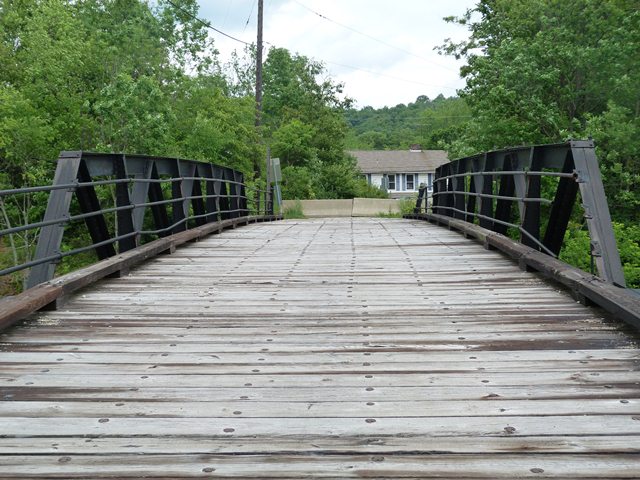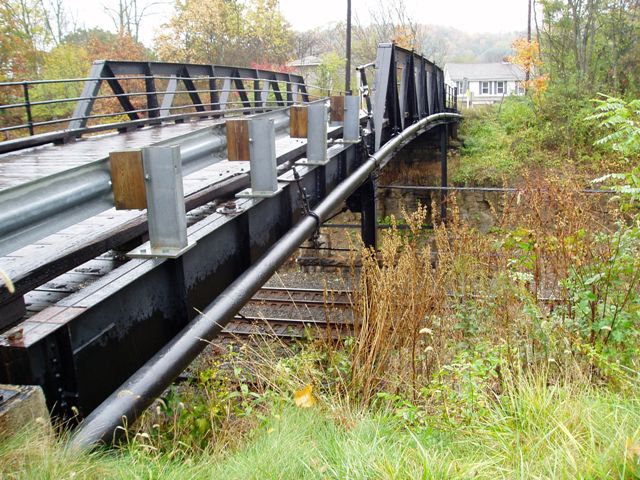We Recommend:
Bach Steel - Experts at historic truss bridge restoration.
BridgeHunter.com Phase 1 is released to the public! - Visit Now
Leger Road Bridge
SR 4019 Bridge

Primary Photographer(s): Nathan Holth
Bridge Documented: October 23, 2006 and June 3, 2012
Ardara: Westmoreland County, Pennsylvania: United States
1902 By Builder/Contractor: American Bridge Company of New York, New York and Engineer/Design: Pennsylvania Railroad
Not Available or Not Applicable
63.0 Feet (19.2 Meters)
120.0 Feet (36.6 Meters)
15.7 Feet (4.79 Meters)
1 Main Span(s) and 2 Approach Span(s)
644019007009610

View Information About HSR Ratings
Bridge Documentation
This bridge's future is at risk!
This bridge was historic on multiple levels. It was an important contributing element to the historic Pennsylvania Railroad main line. Aside from the physical footprint and right-of-way of the railroad line itself, bridges such as the Leger Road Bridge are among the most tangible and important surviving remnants of a historic railroad line. The rails themselves, the railroad ties, and gravel that make up the railroad are mundane elements that have changed little over the past century. Therefore, the historic feel of a historic railroad line is rendered by the preservation of tangible structures such as the Leger Road Bridge.
The bridge was noteworthy in appearance and design for its configuration consisting of a main pony truss span flanked with a girder approach span on either end, as well as for its substructure which included attractive riveted steel bents with bracing. Perhaps one of the most surprising and unique features of the bridge was its railings. While the pole railings it contained were nothing unusual for the period, the ornate cast iron posts at the ends of the railings were extremely unique and very beautiful.
None of this mattered to PennDOT however, who chose to demolish and replace the historic bridge with a slab of concrete. It is doubtful that even the beautiful cast iron railing posts survived the dumpster. At the very least, these posts should have been salvaged and placed near the replacement bridge to stand as reminders of heritage (and preservation opportunities) lost.
Information and Findings From Pennsylvania's Historic Bridge InventoryDiscussion of Bridge The 3 simple span bridge consists of a 62' long riveted, Warren with verticals pony truss main span and 28' long built up deck girder approach spans. The substructure consists of ashlar abutments topped with concrete seats and built up 2 column bents. The truss is a standard PRR design composed of angles and plate. The design was used since the late 19th century. The bridge, which appears to be complete, is finished with three-high pipe railings with cast iron end posts. The stringers and deck are wood. The bridge is historically significant in association with the Pennsylvania RR main line. It is a complete example of their commonly used grade crossing elimination bridge of the period. American Bridge Co. fabricated many bridges for the railroad company. Discussion of Surrounding Area The bridge carries a 2 lane road over 2 tracks of the Conrail/Amtrak (formerly Pennsylvania Railroad main line) and an access road in an area of predominently post-World War II houses. PHMC has determined the PRR main line in Pennsylvania eligible. Bridge Considered Historic By Survey: Yes |
This bridge is tagged with the following special condition(s): Unorganized Photos
![]()
Photo Galleries and Videos: Leger Road Bridge
Bridge Photo-Documentation
Original / Full Size PhotosA collection of overview and detail photos. This gallery offers photos in the highest available resolution and file size in a touch-friendly popup viewer.
Alternatively, Browse Without Using Viewer
![]()
Bridge Photo-Documentation
Mobile Optimized PhotosA collection of overview and detail photos. This gallery features data-friendly, fast-loading photos in a touch-friendly popup viewer.
Alternatively, Browse Without Using Viewer
![]()
2012 Additional Unorganized Photos
Original / Full Size PhotosA supplemental collection of photos that are from additional visit(s) to the bridge and have not been organized or captioned. This gallery offers photos in the highest available resolution and file size in a touch-friendly popup viewer.
Alternatively, Browse Without Using Viewer
![]()
2012 Additional Unorganized Photos
Mobile Optimized PhotosA supplemental collection of photos that are from additional visit(s) to the bridge and have not been organized or captioned. This gallery features data-friendly, fast-loading photos in a touch-friendly popup viewer.
Alternatively, Browse Without Using Viewer
![]()
Maps and Links: Leger Road Bridge
Coordinates (Latitude, Longitude):
Search For Additional Bridge Listings:
Bridgehunter.com: View listed bridges within 0.5 miles (0.8 kilometers) of this bridge.
Bridgehunter.com: View listed bridges within 10 miles (16 kilometers) of this bridge.
Additional Maps:
Google Streetview (If Available)
GeoHack (Additional Links and Coordinates)
Apple Maps (Via DuckDuckGo Search)
Apple Maps (Apple devices only)
Android: Open Location In Your Map or GPS App
Flickr Gallery (Find Nearby Photos)
Wikimedia Commons (Find Nearby Photos)
Directions Via Sygic For Android
Directions Via Sygic For iOS and Android Dolphin Browser
USGS National Map (United States Only)
Historical USGS Topo Maps (United States Only)
Historic Aerials (United States Only)
CalTopo Maps (United States Only)


